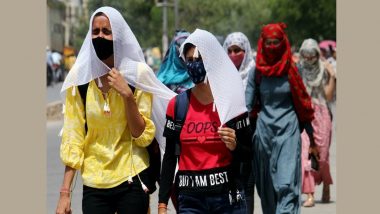New Delhi, April 29: Already reeling under a deadly heatwave, a few places in Delhi are likely to see the mercury touch the 46-degree Celsius mark on Friday, the India Meteorological Department (IMD) said. The Safdarjung observatory -- Delhi's base station -- had recorded a maximum temperature of 43.5 degrees Celsius on Thursday, the highest in April in 12 years.
The national capital had recorded a maximum temperature of 43.7 degrees Celsius on April 18, 2010. The all-time high temperature for the month is 45.6 degrees Celsius, which was recorded on April 29, 1941.
"The temperature at the Safdarjung observatory is likely to go up by 0.5 degree Celsius to 1 degree Celsius on Friday. It may even touch 46 degrees Celsius at some places," senior scientist R K Jenamani said. Haryana, Delhi, western Uttar Pradesh and Madhya Pradesh are likely to log peak temperatures on Friday, he added.
Rajasthan, Delhi, Punjab and Haryana may witness light rainfall and thunderstorm between May 2 and May 4. The maximum temperature will be between 36 degrees and 39 degrees Celsius, Jenamani said. Weather Forecast: Heatwave Conditions to Continue for Next 5 Days Over Northwest, Central India; Rainfall in Northeast, Says IMD.
The IMD has issued an "orange" alert, warning people of a severe heatwave in many parts of Delhi on Friday and Saturday. The Met department uses four colour codes for weather warnings -- "green" (no action needed), "yellow" (watch and stay updated), "orange" (be prepared) and "red" (take action).
Amid the rising heat and growing power demand, the Delhi government on Thursday warned of a possible setback in providing uninterrupted electricity supply for critical services in the capital, including Metro trains and hospitals.
Chief Minister Arvind Kejriwal on Friday said his government is somehow handling the power supply situation in Delhi and called for quick, concrete steps to tackle the electricity crisis facing the country.
The Delhi government has said it will supply around 1,000 million gallons of drinking water every day during the summer season as against 935 MGD earlier to meet the rising demand. The IMD said Delhi may also see a partly cloudy sky, light rain and a dust storm with winds gusting up to 50 kilometres per hour on Friday and Sunday, which may provide temporary respite.
The heatwave is expected to abate from Monday under the influence of a western disturbance, which is likely to affect northwest India from the night of May 1, it said. On Thursday, the mercury had leaped to 46 degrees Celsius at Sports Complex. Ridge (45.1 degrees Celsius), Mungeshpur (45.8 degrees Celsius), Najafgarh (45.4 degrees Celsius) and Pitampura (45.2 degrees Celsius) recorded the maximum temperature at least five notches above normal.
"A maximum temperature of 45 degrees Celsius is normal at places like Churu, Barmer, Bikaner and Sriganganagar in Rajasthan, but 45-46 degrees Celsius in the plains of north India by April-end is quite unusual," independent meteorologist Navdeep Dahiya said. Wedding Procession Makes Portable Sun Shade to Beat the Heatwave, ‘Jugaad’ Leaves Internet Dazzled (Watch Video).
The city has recorded nine heatwave days in April, the highest since 11 such days witnessed in the month in 2010. Delhi falls in the Core Heatwave Zone (CHZ), comprising the most heatwave-prone areas of the country, along with Telangana, Andhra Pradesh, Himachal Pradesh, Uttarakhand, Haryana, Uttar Pradesh, Rajasthan, Madhya Pradesh, Maharashtra, Bihar, Chhattisgarh and West Bengal.
Northwest India has been recording higher-than-normal temperatures since the last week of March, with weather experts attributing it to the absence of periodic light rainfall and thundershowers, which typify this time of the year, due to the lack of active western disturbances.
The region had got some respite last week owing to cloudy weather due to the influence of a western disturbance over Afghanistan. The IMD said the heatwave could lead to "moderate" health concerns for vulnerable people -- infants, elderly people and those with chronic diseases.
"Hence, people of these regions should avoid heat exposure, wear lightweight, light-coloured, loose cotton clothes and cover the head with a piece of cloth, a hat or an umbrella," it said. There is an "increased likelihood of heat-illness symptoms in people who are either exposed to the sun for a prolonged period or doing heavy work", an IMD advisory read.
For the plains, a heatwave is declared when the maximum temperature is over 40 degrees Celsius and at least four-and-a-half notches above normal. A severe heatwave is declared if the departure from the normal temperature is by more than 6.4 notches, according to the IMD.
Based on the absolute recorded temperatures, a heatwave is declared when an area logs a maximum temperature of 45 degrees Celsius. A severe heatwave is declared if the temperature crosses the 47-degree mark. India saw its warmest March this year since the IMD began keeping records 122 years ago amid a 71-per cent rain deficit. Parts of the country are also seeing wheat yields drop by up to 35 per cent due to the unseasonal heat.













 Quickly
Quickly


